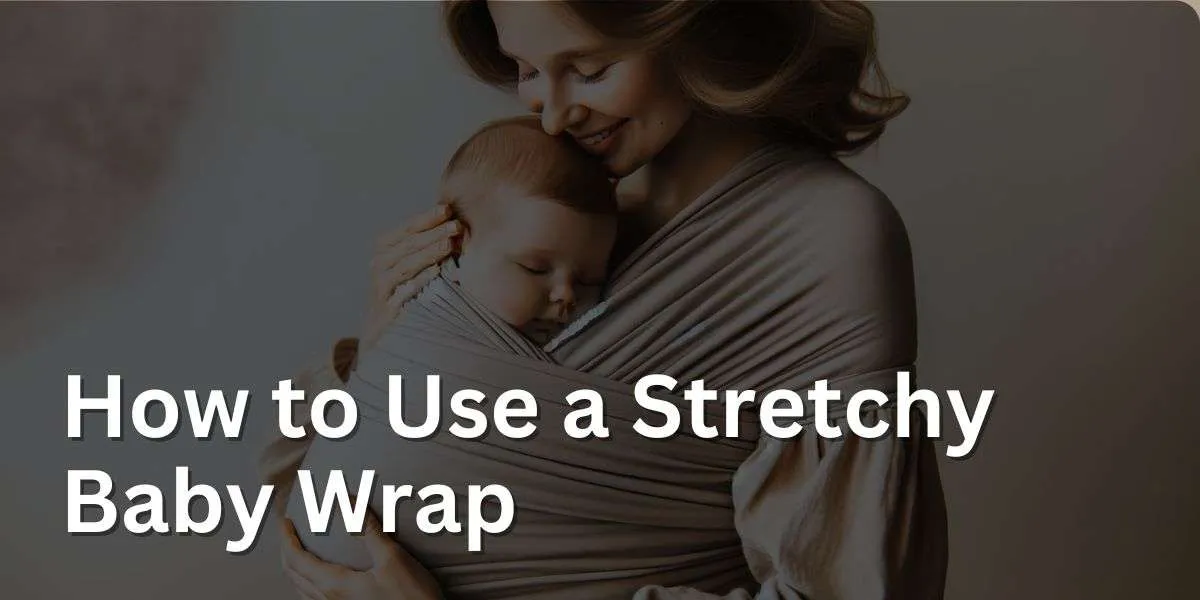Using a stretchy baby wrap can be a comforting and bonding experience for both parent and baby, but it’s important to understand the correct way to use it for safety and comfort.
This article will provide a step-by-step guide on how to use a stretchy baby wrap. We’ll cover the basics of selecting the right wrap, preparing it for use, and the proper technique to ensure your baby is secure and supported.
Whether you’re a first-time parent or new to using a stretchy wrap, this guide will equip you with the knowledge and confidence to enjoy the benefits of babywearing safely and comfortably.
Key Takeaways: Using a Stretchy Baby Wrap
- Familiarize yourself with the wrap. Stretchy wraps are long pieces of fabric, and understanding how to manipulate the material is key.
- Practice wrapping techniques. There are various methods to wrap, such as the pocket wrap cross carry, which are essential to learn for safe and comfortable babywearing.
- Ensure a snug fit. The wrap should be tight enough to hold the baby securely while allowing for some stretch for comfort.
- Support the baby’s back and hips. Proper positioning is crucial for safety and comfort; the baby should be seated in an ergonomic ‘M’ shape.
- Keep the baby’s airway clear. Ensure that the baby’s face is always visible and not pressed against the fabric or your body.
- Start with the wrap centered on your body. This provides a balanced starting point for wrapping and carrying the baby.
- Position the baby high and upright. The baby’s head should be close enough to kiss, and their body upright against your chest.
- Spread the fabric over the baby’s body. This provides even support and helps distribute the baby’s weight.
- Check for comfort and adjust as needed. Both you and the baby should be comfortable, so make adjustments to the wrap if necessary.
- Practice in a safe environment. Initially, try using the wrap over a bed or soft surface in case of any mishaps while learning.
How to Use A Stretchy Wrap: Step by Step Guide
Using a stretchy baby wrap can seem daunting at first, but with practice, it becomes an easy and comfortable way to carry your baby. Here’s a step-by-step guide to help you get started to do a hip wrap cross carry or a newborn front wrap cross:
Preparing the Wrap
- Lay Out the Wrap: Unfold your stretchy wrap completely. Most wraps are long pieces of fabric without any buckles or rings.
- Find the Middle: Locate the middle of the wrap. Many wraps have a tag or a mark indicating the center.
Creating the Base
- Place Across Your Waist: Hold the middle of the wrap against your stomach.
- Cross Behind Your Back: Take both ends of the wrap behind your back, cross them over in the middle of your back, and bring them over your shoulders to the front. Ensure that the fabric is spread wide across your back for support.
Securing the Wrap
- Create an ‘X’ on Your Front: After bringing the ends over your shoulders, cross them in front of your chest. Spread the fabric out so it covers from one shoulder to the opposite waist, creating a secure pouch for the baby.
- Wrap Around Your Waist: Take the ends of the wrap and pass them around your waist to the back. Cross them at your back and then bring them back to the front. If there’s enough fabric, you can take them to the back again and tie a knot. If not, tie a knot at the front or side of your waist.
Placing the Baby
- Prepare to Place the Baby: Before placing the baby in the wrap, ensure it’s snug but not too tight. You should be able to slide your hand between the wrap and your body.
- Position the Baby: Hold your baby against your chest. Gently separate the cross fabric on your front and place the baby in the ‘X’ you created. The baby’s legs should be in a natural, spread-squat position (the “M” position), with knees higher than their bottom.
- Secure the Baby: Pull each side of the ‘X’ fabric over the baby’s back, spreading the fabric from one knee to the other. Ensure the baby’s back and neck are supported, and their face is visible and close enough to kiss.
- Use the Horizontal Fabric: Pull the horizontal section (where you initially placed the middle of the wrap) up and over the baby. This provides additional support.
Safety Checks
- Check the Baby’s Position: Ensure the baby’s airway is clear, and they are sitting comfortably in an ergonomic position and you have the wrap tight.
- Comfort Adjustments: Adjust the wrap for your comfort. The fabric should be evenly distributed over your shoulders and back.
Final Tips
- Practice: Practice putting on the wrap a few times without the baby to get a feel for the correct tension and fit.
- Mirror Check: Use a mirror to help you see and adjust the wrap as you learn.
- Safety First: Always follow the TICKS guidelines for safe babywearing (Tight, In view at all times, Close enough to kiss, Keep chin off the chest, Supported back).
Whilst some people use a stretchy wrap for a hip carry, with a hip wrap cross carry or a robin’s hip carry, we generally don’t recommend it and recommend a woven wrap baby carrier for those types of carries.
Time to learn how to use baby wraps.
The great thing about stretchy baby wraps is that you can put them on and then just put your baby in and take them out through the day without having to take the sling off. It is great for hands free carrying around the house, on quick trips to the shops, getting in and out of car seats, walking the dog and just about any other time you can think of! Plus they are one size fits all so ideal for switching between care givers.
Top Tips:
- Ensure your sling is swimsuit tight before you put your baby in, your baby will sit in the stretch of the wrap, too loose and the fabric will sag and not support your baby adequately.
- Practice! You can start to practice with your baby wrap carrier while pregnant, use a teddy, use a mirror, the more you practice before your baby arrives the better, you’ll thank me when you try to use the wrap to soothe a crying baby, the sooner you can get your baby into the carrier the better!
- Rock and sway, shift your weight from foot to foot as you put your baby in the wrap, keep them calm, keep yourself calm, you got this! Babies can sense when you are stressed, it stresses them, which starts a vicious circle, so keep calm.
Troubleshooting Tips on Stretchy Baby Wrapping
Baby is Uncomfortable or Fussy
Possible cause: Wrap is too tight or too loose.
Solution: Double-check your wrap to ensure it’s snug, but not excessively tight. Baby’s back should be well-supported and their knees should be higher than their bottom in the “M” position. Make necessary adjustments and give your baby a bounce to help them settle.
Difficulty Tying the Wrap
Possible cause: Wrap is twisted or tangled.
Solution: Lay your wrap out flat and follow step-by-step instructions while keeping the fabric untwisted. Practicing may improve tying speed and efficiency.
Uneven Weight Distribution
Possible cause: Wrap is tied off-center, or baby is improperly positioned.
Solution: Ensure the wrap’s center logo is aligned with your navel during tying. When positioning your baby, make sure they’re centered on your chest. Shift baby’s weight as needed for comfort.
Trouble Running Errands while Babywearing
Possible cause: Limited mobility; hard to access items.
Solution: Try wearing a crossbody bag or backpack to store your belongings and keep your hands free. This will help make errands easier while wearing your baby.
Remember, practice makes perfect. Don’t be discouraged if it takes a few tries to get your baby wrap just right. A properly tied wrap ensures your baby’s safety and comfort, making it worth perfecting your technique!
Difference Between Woven Wraps and Stretchy Wraps
Here are some key characteristics of stretchy baby wraps:
- Material: Stretchy wraps usually use a blend of spandex or elastane with another fabric like cotton or viscose. This blend gives the wrap its elasticity and softness.
- Support: They are typically more suitable for newborns and smaller babies, providing a hug-like feeling that will make your baby feel cozy and snug.
- Ease of use: Stretchy wraps can have a bit of a learning curve when it comes to tying them, but once you get the hang of it, they are relatively easy to use and adjust as needed.
- Hybrid wraps: These wraps combine the support of woven wraps with the stretchiness of stretchy wraps. A hybrid wrap may be a good option if you’re looking for a combination of support and comfort.
Here’s a brief comparison table of these two main wrap types:
| Stretchy Wrap | Woven Wrap | |
|---|---|---|
| Material | Stretchy (e.g., cotton/spandex) | Less stretchy (e.g., cotton/linen) |
| Support | Suitable for newborns/infants | Supports up to toddler age |
| Ease of use | Moderate | Slightly more challenging |
| Hybrid wrapper | Yes | No |
Which Baby Wrap Carrier Should I Choose?
We have a huge range of baby carriers to choose from including soft structured carriers, ring sling carriers, stretchy and traditional woven wraps. We have chosen the brands carefully as we feel they are the best on the market.
In this video, we have used the Lillebaby Tie The Knot stretchy wrap, similar to a moby wrap or boba wrap. It is incredibly light and thin, made using carbon-neutral Tencel. The material is perfect for hot babies and wearers alike, excellent in the warmer summer months (but still perfect for cooler months, just layer up clothing as appropriate) but don’t let the light weight of this wrap fool you, it’s really supportive too. I love it because it doesn’t feel constricting even with three layers.
Of course, we do stock other wraps if you prefer, the Je Porte Mon Bebe baby sling carrier is firm favourite, thicker and very supportive, the original baby carrier is designed not just for a newborn, but as a hybrid wrap right through the journey, even suitable for back carries.
How do I carry my baby safely?
There are many many myths on facebook, we’ve dealt with a few before, but please rest assured that as babywearing specialists we take the safety of your baby incredibly seriously, we have spent hundreds of hours training and researching baby carriers to ensure that the baby slings we stock are safe. As with anything, it is only safe if you use it as intended, following the instructions, but used correctly none will harm your baby. We’ve devised this handy (pun intended) pneumonic to help you ensure your baby is safe, I’ll talk you through it in the video.
How to Wash a stretchy wrap
As you move along your babywearing journey, you may pick up a few stains! There are a few general tips for washing baby carriers, but do always follow manufacturer instructions when washing your baby wrap.







